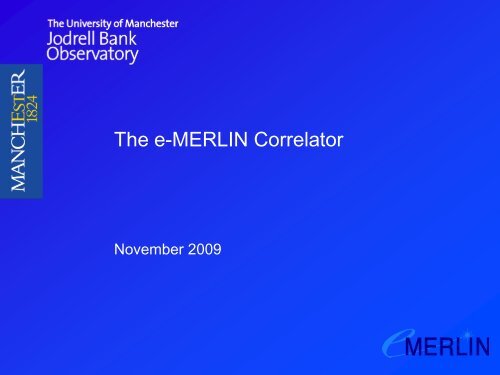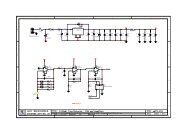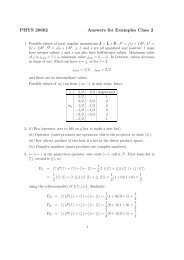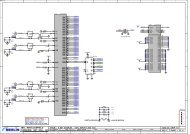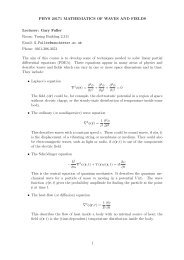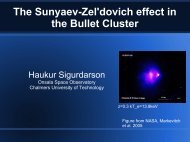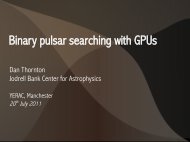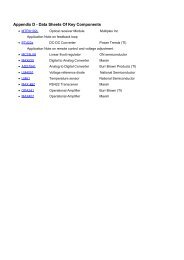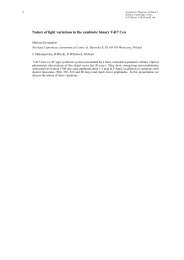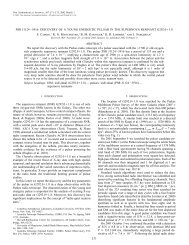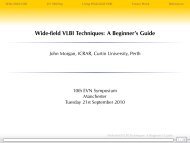The e-MERLIN Correlator
The e-MERLIN Correlator
The e-MERLIN Correlator
You also want an ePaper? Increase the reach of your titles
YUMPU automatically turns print PDFs into web optimized ePapers that Google loves.
<strong>The</strong> e-<strong>MERLIN</strong> <strong>Correlator</strong><br />
November 2009
<strong>Correlator</strong> Basics 1
<strong>Correlator</strong> Basics 2<br />
• Typically the delay,<br />
phase rotation and<br />
correlation are carried<br />
out on digitised<br />
signals.<br />
• <strong>The</strong> phase rotation,<br />
lags, multiplication<br />
and accumulation are<br />
done in purposedesigned<br />
correlator<br />
chips.
<strong>The</strong> e-<strong>MERLIN</strong> <strong>Correlator</strong><br />
• <strong>The</strong> simple correlator just described is<br />
unsuitable for e-<strong>MERLIN</strong>, because e-<strong>MERLIN</strong><br />
has up to a 2 GHz bandwidth.<br />
• E-<strong>MERLIN</strong> uses the WIDAR correlator<br />
developed by Brent Carlson at DRAO. <strong>The</strong><br />
same (but larger) correlator is used for the<br />
eVLA.<br />
• <strong>The</strong> WIDAR approach splits the wideband<br />
signal into a number of narrower sub-bands<br />
which are practicable to deal with.
WIDAR Basics
WIDAR Aliasing 1<br />
• In theory the resultant sub-bands can be<br />
stitched together to reconstruct the wideband<br />
spectrum.<br />
• However there is a problem with the “transitionbands”<br />
─ the out-of-band response of the FIR<br />
filters.<br />
• Signals in these parts of the band will aliased<br />
into the “in-band” part.
WIDAR Aliasing 2<br />
• <strong>The</strong> aliasing problem can be effectively<br />
removed by applying a different frequency<br />
offset to each telescope.<br />
• In this case, the aliased signals will de-correlate<br />
after the removal of the offset in the correlator.
WIDAR Aliasing 3
<strong>The</strong> e-<strong>MERLIN</strong> <strong>Correlator</strong> in<br />
Practice
Station Board
Baseline Board 1
Baseline Board 2<br />
• <strong>The</strong> correlator chips are arranged in an 8 x 8<br />
matrix.<br />
• Each chip contains 4 Quads (CCQ) each of 4<br />
independent 128 complex-lag <strong>Correlator</strong> Chip<br />
Cells (CCC). Each Quad can therefore correlate<br />
all four polarisation products.<br />
• Adjacent CCCs and CCQs can be<br />
concatenated to dedicate more lags to a<br />
particular product.<br />
• Each chip has 8 X and 8 Y inputs.
<strong>Correlator</strong> Chip Multiplier Module
<strong>Correlator</strong> Control<br />
• Each board has its own processor running<br />
Linux which is responsible for loading and<br />
servicing the FPGAs and related items. <strong>The</strong><br />
programming is largely in C.<br />
• <strong>The</strong> correlator itself is controlled by a separate<br />
computer (also Linux) which serves out the OS<br />
to the board processors. This talks to the<br />
outside world via the “Virtual <strong>Correlator</strong><br />
Interface”, and via engineering GUIs.<br />
Programming is in C and Java.
E-<strong>MERLIN</strong> Control Software<br />
• <strong>The</strong> e-<strong>MERLIN</strong> control software provides the<br />
interface to the operators, configures the<br />
correlator, sequences the observations, and<br />
captures the data from the correlator.<br />
• It talks to the correlator using the VCI and to the<br />
telescopes via the Outstation Telescope Control<br />
Computer.<br />
• It is programmed entirely in C++.
Things I Haven't Mentioned<br />
• Input and output state counts.<br />
• Clip counts.<br />
• Power counts.<br />
• Noise diode binning.<br />
• Pulsar binning and gating.<br />
• Phase tone extraction (not used by e-<strong>MERLIN</strong>).<br />
• Phasing (not used by e-<strong>MERLIN</strong>).
Summary of <strong>Correlator</strong> Capabilities<br />
• Bandwidth 2 GHz (3-bit sampling) or 1 GHz (8-<br />
bit sampling).<br />
• Can provide 4 GHz bandwidth with only one<br />
polarisation.<br />
• 512 spectral channels per sub-band per<br />
polarisation without recirculation. (1024 with<br />
only two polarisations.)<br />
• Up to 131072 spectral channels per sub-band<br />
per polarisation with recirculation.


